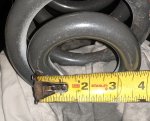For actual desert racing, my take is that matching front/rear frequencies can be important for stability. On longer wheelbase vehicles its less important though. A natural frequency in the comfort range is a good starting point. Higher frequencies cause a ride to feel harsh, especially with lots of unsprung weight. Which then necessitates high damping rates. Which finally increases suspension response time, transferring more energy to the chassis. Obviously there are control issues with too low of a frequency, but thats typically handled best with sway bars, and shock tuning.
Really all frequency is telling you is the ratio of mass to spring rate. Its a convenient way to set a starting spring rate. To maximize usable travel, lower is better. Go too low and your suspension can skip over a very rough surface. Then use bump stops, shock valving, or progressive springs to control bottom/topping effects. For track racing etc, they often choose a much higher spring rate. Which has a lot more to do with suspension response time and weight transfer than comfort.
My take is to choose a rate which lets you have good usable travel and ride height with minimal preload. Then have the shock tuned to control bottoming, and prevent stacking or slow response. A position sensitive shock can help with really frequency/rate, as you get high rates at the top/bottom, but faster response (less damping) in the middle range (typical travel).







